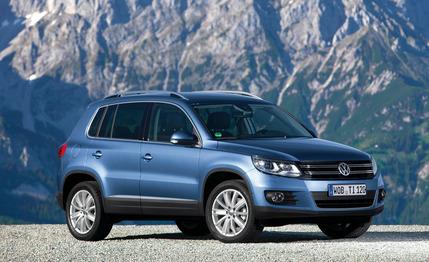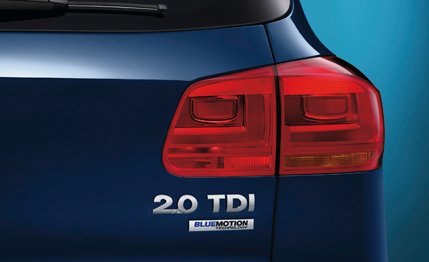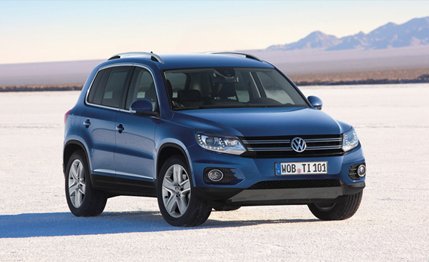 First Drive Review
First Drive Review
Volkswagen’s North American division is staffed by deacons. How else can you explain the company offering the automotive enthusiasts’ equivalent of the holy trinity: a stick-shift, diesel-burning station wagon? The company’s U.S. chief, Jonathan Browning, has said that he aims to make a diesel engine available in most, if not all, of the company’s offerings on these shores. For some, the wait will be short. Besides that holy Jetta—and the Golf and Passat that are already available—the newest Beetle will offer a dizzler by this time next year. Others will need more patience. Take Volkswagen’s oft-forgotten Tiguan crossover. This competent, moderately popular Golf on stilts just received a mid-cycle refresh. Sifting through the specs, we see that the American-market Tiguan gets a new front fascia and a new transmission. But where’s the diesel? Stuck in Europe. So off we went to see what we’re missing—and how that new snout looks up close.
The Less Things Change, the More They Stay the Same
For 2012, the U.S.-market Tiguan has been just slightly altered, with the aim of bringing its styling more in line with the company’s current theme. Rather than modeling the new Tiguan after an IRS form 1099—the apparent inspiration for the new Jetta and Passat—the Tiguan now more closely resembles the bigger, better-reputed Touareg. The soggy-looking front fascia sported by last year’s Tiguan has been replaced, and the new squared-off grille and headlights go a long way to butch up the little trucklet. European shoppers can choose from two different front fascias depending on the trim level, but the one that the Germans call “Track & Field” is what’s coming here. That means our Tiguan gets trapezoidal openings for fog lights on the lower part of the front clip, as well as a pretend skid plate under its chin. The taillights have also been updated, with last year’s globular design replaced by rectangular units more like those you’d find on the Touareg.

We sampled the 2012 Tiguan with the powertrain American enthusiasts would say they want: the all-wheel-drive diesel with a six-speed manual. Underhood, this VeeDub features the corporate 2.0-liter turbo-diesel, good for 140 hp and 236 lb-ft of torque. (In comparison, the turbocharged 2.0-liter gasoline-fed engine in the U.S.-market Tiguan makes 200 hp and 207 lb-ft of torque.)
Would you be shocked to learn that the diesel is just as great an engine here as it is in the Golf, Jetta, and Passat? Despite the heft of the Tiguan—some 3850 pounds—Volkswagen’s ubiquitous diesel proved itself to be the little engine that could, hauling the crossover over treacherous unpaved flat, dry roads with enthusiasm. It remains a model for diesel refinement, with smooth and quiet operation. Our only complaint is the brief wait for the turbo to spool; whereas the diesel’s power always feels sufficient in a lighter vehicle like the Golf, a four-wheel-drive Tiguan requires more oomph. While we’re not talking about lag on the scale of an ’80s Saab, you’ll never mistake the 2.0-liter diesel for a BMW turbo. But the gearbox delivers everything you expect from VW, with slick action from the shifter and a clutch pedal that’s light enough that it’ll never tire your leg from frequent gear changes (or tell you what’s actually happening down at the flywheel). A seven-speed dual-clutch automatic also is on offer as an option for Europeans who hate their left feet. Price-wise, the TDI commands about $1500 more than the 2.0-liter turbocharged gas engine does in Europe.
The old trope of the “soft”-roader—the crossover that’s better on tarmac than in the mud—still applies to the Tiguan. On-road handling borders on fun, and the Tiguan has decent steering feel in spite of tires with relatively tall sidewalls. The high seating position inherent in the crossover design is convenient for planning your next pass around a dawdling French econobox—but, as is frequently the case, leaves us wishing that this jacked-up Golf had a little less body roll in hasty cornering. (For Europeans who want a bit more Red Bull in their muesli, we are happy to recommend the Tiguan’s sibling, the Audi Q3, which will be released from the asylum with an available 310-hp turbocharged five-cylinder engine.)
Dynamics, of course, are of secondary—or tertiary—importance for this vehicle. The diesel-fuelled Tiguan is meant, first and foremost, to cart kids and cra—er, parcels—around town. With a diesel that’s rated at 41 mpg in the combined European cycle, this may be the most sensible Tiguan on offer anywhere. While we—and the rest of the diesel/stick/wagon evangelists—would rather have the still-more-sensible Golf or Jetta SportWagen with a diesel engine, Europeans and Americans alike are hot for crossovers. With this car as a reference point, we’re sure that when the next-gen Tiguan arrives in the States in a few years packing a diesel engine and a lower price, that most sensible insensible vehicle will have no trouble finding fans.
